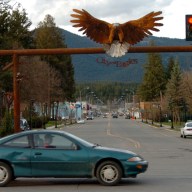PASADENA, Calif. – A NASA spacecraft plunged into the atmosphere of Mars and landed in the Red Planet’s northern polar region on Sunday to begin 90 days of digging in the permafrost to look for evidence of the building blocks of life.
Cheers swept through mission control at NASA’s Jet Propulsion Laboratory when the touchdown signal from the Phoenix Mars Lander was detected after a nailbiting descent.
“In my dreams it couldn’t have gone as perfectly as it went,” project manager Barry Goldstein said. “It went right down the middle.”
Among Phoenix’s first tasks were to check its power supply and the health of its science instruments, and unfurl its solar panels after the dust settled.
Mission managers said there would be a two-hour blackout period as Phoenix conducted the checks while out of view from Earth.
Phoenix plunged into the Martian atmosphere after a 10-month voyage through space.
Among the things it carried was a Canadian weather station. The $37 million station is about the size of a big shoebox.
The station, which is wrapped in a thermal blanket bearing a tiny Maple Leaf flag, is to help in the water search. It’s the first Canadian science instrument to land on the surface of an alien world.
A Canadian scientific team hopes to spend 90 days studying data sent back from Mars. The daily weather reports will include temperature, atmospheric pressure, cloud height, humidity and wind speeds.
A specially developed Canadian laser instrument known as a lidar will be used to track clouds around the landing area.
Steve MacLean, chief astronaut for the Canadian Space Agency, told The Canadian Press on Sunday that Canada got involved in the project because of its expertise operating in a frigid northern environment.
“This is the first time that we have an instrument that we sponsored as a nation” on such a space mission, he said.
“All the measurements that we did in the North over the last 15 years contributes to us being a major player on this mission.”
The weather station Canada built for the mission is able to provide regular readings on the temperature on Mars, atmospheric pressure, cloud height, humidity and wind speed.
The lidar system comes from Alan Carswell at York University in Toronto, who ran a laboratory and then spun off a company called OPTECH to develop a larger role for Canada in the space program.
MacLean says Carswell has emerged as a central figure in the Mars mission and is at the Phoenix mission control centre overseeing the operation.
It’s the first successful soft landing on Mars since the twin Viking landers touched down in 1976.
NASA’s twin rovers, which successfully landed on Mars four years ago, used a combination of parachutes and cushioned air bags to bounce to the surface.
Phoenix’s landing is a relief for NASA since Mars has a reputation of swallowing spacecraft. More than half of all nations’ attempts to land on Mars have failed.
Phoenix’s target landing site was a 50-kilometre-wide shallow valley in the high northern latitudes similar in location to Earth’s Greenland or northern Alaska.
The site was chosen because images from space spied evidence of a reservoir of frozen water close to the surface.
Like a tourist in a foreign country, the lander initially will take in the sights during its first week on the Red Planet.
It will talk with ground controllers through three Mars orbiters, which will relay data and images.
Phoenix is equipped with a 2.5-metre-long arm capable of digging trenches in the soil to get to ice that is believed to be buried there. It will study the dirt and ice samples for traces of organic compounds, the chemical building blocks of life.
The lander also will study whether the ice ever melted at some point in Mars’ history when the planet had a warmer environment than the current harsh, cold one it currently has.
Scientists don’t expect to find water in its liquid form at the Phoenix landing site because it’s too frigid.
They say that if raw ingredients of life exist anywhere on the planet, they likely would be preserved in the ice.
Phoenix, however, cannot detect signs of alien life that may exist now or once existed.
The only other time NASA searched for chemical signs of life was during the Viking missions.
Neither lander found conclusive evidence of life.
Phoenix avoided the doom of its sister spacecraft, the Mars Polar Lander, which in 1999 crashed into the south pole after prematurely cutting off its engines.
The Polar Lander loss, along with the earlier loss of an orbiter the same year, forced NASA to overhaul its Mars exploration program.
Phoenix, named after the mythical bird that is reborn from its ashes, inherited hardware from a lander mission that was scrapped after the back-to-back Mars losses, and carries similar instruments that flew on Polar Lander.
Built by Lockheed Martin Corp., Phoenix is the first mission from NASA’s Scout program, a lower-cost complement to the space agency’s pricier Mars missions.
It cost $420 million to develop and launch Phoenix compared to the $820 million originally invested in the twin rovers.
The rovers have dazzled scientists with their Energizer Bunny-like ability to keep going and their geologic findings that ancient Mars once had water that flowed at or near the surface.
Mission managers don’t expect Phoenix to be as hardy as the rovers since winter will set in later this year at the landing site with fewer hours of sunlight available each day to power the lander’s solar panels.
(With files from The Canadian Press)
















